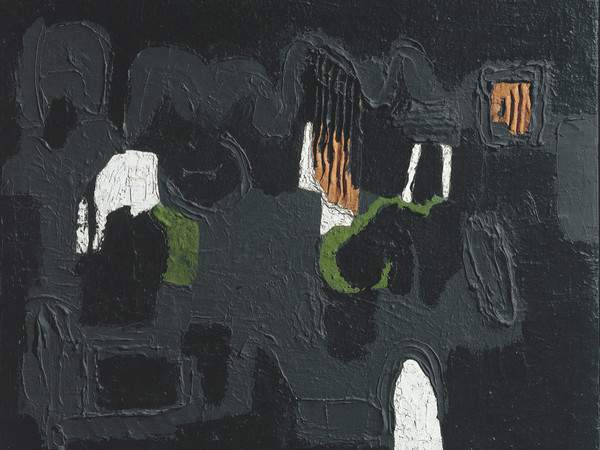Senigallia City of Photography, Museo MAXXI and Fondazione Palazzo Albizzini Collezione Burri present Giacomelli / Burri. Photography and Material Imagery, a major traveling exhibition dedicated to two great artists of the 20th century, Mario Giacomelli and Alberto Burri. The exhibition recounts, through a substantial nucleus of photographs dedicated by Giacomelli to Burri, relating to a personal vision of landscape and land (in dialogue with Informal painting), and letters and archival documentation, the artistic and human events that linked two artists.
The exhibition, curated by Marco Pierini, produced with the City of Senigallia and promoted by Fondazione MAXXI, Fondazione Palazzo Albizzini Collezione Burri, Archivio Giacomelli and Archivio Sarteanesi, kicked off on July 1 at Palazzo Del Duca in Senigallia, and will move in the fall to the MAXXI Museum in Rome under the curatorship of Bartolomeo Pietromarchi, and then to the Fondazione Palazzo Albizzini Collezione Burri in Città di Castello, in the Ex Seccatoi del Tabacco venue, with a stage curated by Bruno Corà. The works on display come from the Fondazione Palazzo Albizzini Collezione Burri, the Mario Giacomelli Archives in Senigallia and Sassoferrato, the Sarteanesi Archive and the Galleria dello Scudo in Verona.
The lives of Mario Giacomelli and Alberto Burri have intertwined several times over the years, in a relationship of mutual esteem and admiration that has flowed into a common quest, which this exhibition aims to investigate by placing their works of both painting and photography in dialogue. Around 1966, the first meeting between the two took place, thanks to the intercession of Nemo Sarteanesi (a painter, intellectual and friend of Burri’s) who casually met Giacomelli in Senigallia.
The exhibition at Palazzo del Duca features an important nucleus of photographs that Mario Giacomelli dedicated to Alberto Burri and Nemo Sarteanesi and that belong to the funds of the Fondazione Palazzo Albizzini Collezione Burri and the Giacomelli and Sarteanesi Archives. Through the important evidence of landscape shots belonging to series such as Presa di coscienza sulla natura, Storie di Terra or Motivo suggerito dal taglio dell’albero, the link between Giacomelli’s and Burri’s poetics and styles is reconstructed and examined, creating a dialogue between painting and photography through “abstract” and “informal” language.
The exhibition will also include a pictorial work by Giacomelli that the artist made before devoting himself entirely to the photographic medium. His celebrated landscape photographs will then be juxtaposed with some graphic and unique works by Alberto Burri (such as the series Combustioni 1965, Cretti 1971, and again, Sacchi, Combustioni on paper and wood, a precious white Cretto) tracing affinities in the formal organization of the space of the work and with respect to a latent zenithal vision of the landscape, rendered in the juxtapositions of the different materials.
This encounter between the two greats would mark Giacomelli’s activity and his choice to devote himself totally to photography: “When I met him I was painting, I was between figurative and abstract, but afterwards I was too influenced by his painting and I stopped. He fascinated me too much, I couldn’t do otherwise.”
In 1968, under the guidance of Nemo Sarteanesi, and in 1983 through Nemo Sarteanesi at the direction of the now-born Palazzo Albizzini Foundation, exhibitions were inaugurated in Città di Castello dedicated to Giacomelli. And if in the first one in 1968 there is a photograph titled Paesaggio Burri, in the second one a series of eight landscape photographs dedicated to the master from Todi is exhibited, as if to sanction a relationship of friendship, esteem and affinity. The critical text is by Arturo Carlo Quintavalle, who states, “he does not read his Marche or the central-Italian Apennines as a postcard landscape, instead he becomes the designer of a research, of an art that rethinks a territory. In short, a different idea, a land art that penetrates deep into history, [...] linked to a different sense of matter and its duration. [...] Giacomelli’s large landscapes are dense with fear, with a very harsh sense of death, like many of Burri’s paintings.”
Giacomelli’s interest in landscapes we know began very early on, when he began photographing the countryside around Senigallia, with his eyes turned to the land, an activity he would continue to pursue until his death.
The exhibition Giacomelli / Burri. Photography and Material Imagery thus aims to emphasize the dialogue that took place between these two great artists and the influences they had on each other.
“It does not seem daring,” writes Marco Pierini, “to read Giacomelli’s research on landscape and some of Alberto Burri’s cycles in parallel. To a gaze indifferent to the categories and conventions of criticism, it will in fact appear evident, beyond an epidermal formal proximity, the analogous aptitude to construct the image as a synthesis, an abstract reconfiguration on the surface of the work of a visual unity generated by the same feeling of nature.”
The Senigallia City of Photography project is realized with the contribution of the Marche Region.
For all information you can call +39 366 679.79.42, send an email to circuitomuseale@comune.senigallia.an.it or visit www.comune.senigallia.an.it.
Pictured: Alberto Burri, Nero (1951). © Sarteanesi Archive
 |
| Mario Giacomelli and Alberto Burri star in an exhibition in Senigallia |
Warning: the translation into English of the original Italian article was created using automatic tools. We undertake to review all articles, but we do not guarantee the total absence of inaccuracies in the translation due to the program. You can find the original by clicking on the ITA button. If you find any mistake,please contact us.